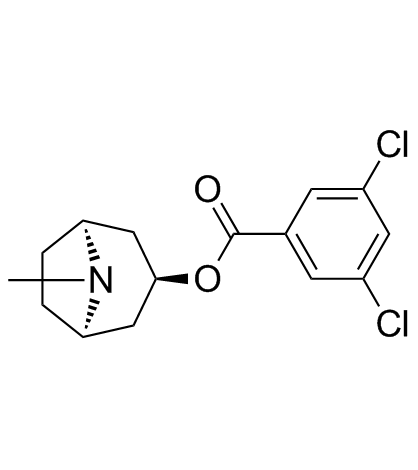| Cas No.: | 40796-97-2 |
| SMILES: | ClC1=CC(=CC(Cl)=C1)C(=O)OC2C[C@H]3N(C)[C@H](CC3)C2 |
| Formula: | C15H17Cl2NO2 |
| M.Wt: | 314.21 |
| Purity: | >98% |
| Sotrage: | 2 years -20°C Powder, 2 weeks 4°C in DMSO, 6 months -80°C in DMSO |
| Description: | In Vitro Blockade of 5-HT3 receptor with Bemesetron (MDL7222) reduces hydrogen peroxide-induced neurotoxicity in cultured rat cortical cells. Bemesetron (0.01, 0.1 and 1 μM, 15 hours) and Y25130 (0.05, 0.5 and 5 μM) concentration-dependently reduce the H2O2-induced decrease of MTT reduction showing 74.9±2.4 and 79.0 ±2.5% with 1 μM and 5 μM, respectively, which are maximal effects. Pretreatment (20 minutes) with Bemesetron (1 μM), Y25130 (5 μM) or MK-801 (10 μM) significantly, but not completely, inhibits the H2O2-induced elevation of [Ca2+]c. Bemesetron (1 μM, 15 hours) significantly blocks the H2O2-induced increase of caspase-3 immunoreactivity. In Vivo Bemesetron (0.1, 1 and 10 mg/kg; i.p.) is used in male adult albino mice. The lowest dose do not cause any significant change in catalepsy. However, Bemesetron (1 mg/kg) causes a significant reduction of catalepsy (from 90 min after Haloperidol), while 10 mg/kg significantly potentiates the phenomenon (from 60 min after Haloperidol). The maximum inhibition of catalepsy (about 75%) occurs at 120 min, and the maximum potentiation (about 4.5-times the control value) occurs at 60 min after Haloperidol. |

 To enhance service speed and avoid tariff delays, we've opened a US warehouse. All US orders ship directly from our US facility.
To enhance service speed and avoid tariff delays, we've opened a US warehouse. All US orders ship directly from our US facility.




















